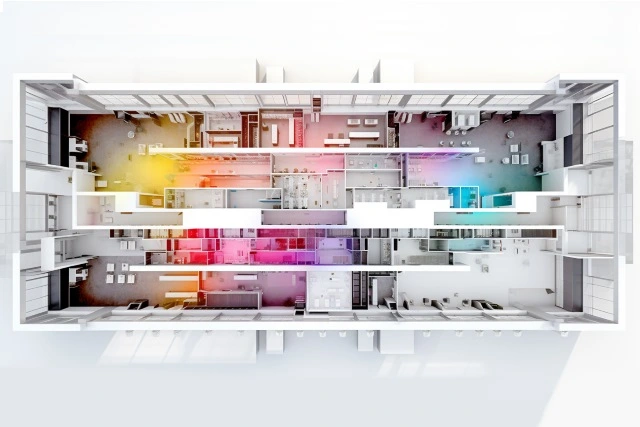Understanding workplace occupancy became significantly more important with the introduction of hybrid work and flexible workspaces. It allows building managers to optimize spaces making them smarter, safer, and more efficient. However, the General Data Protection Regulation (GDPR) sets comprehensive regulations for protecting an individual’s privacy and personal data, including occupancy data.
Understanding the role of presence sensors in workplace occupancy
Presence sensors also referred to as occupancy sensors, detect and track the occupancy of a room by monitoring movements with sensor technology such as infrared, video analysis, or radio frequency identification (RFID). With impressive accuracy, presence sensors quietly count the number of people present, providing real-time data on occupancy. This information allows building owners to optimize building systems and spaces based on occupancy.
Navigating GDPR compliance in workplace occupancy sensors
At its core, the GDPR establishes a robust framework governing the collection, processing, and storage of personal data. This can include occupancy data if it can identify an individual and their location such as sensors that use video or biometrics. To comply with the GDPR, building owners need to:
- Acquire consent for collecting occupancy data
- Clearly communicate the purpose, duration, and rights related to the data collection
- Implement strong security measures, such as encryption, access controls, and regular data audits
- Comply with data subject access requests
Your privacy and personal data
The GDPR establishes clear rights for all EU citizens regarding the use and access of their personal data. It allows individuals to access and review the data collected about them, request corrections or deletions, and limit or object to the processing of their data. Organizations must provide accessible ways for individuals to exercise these rights.
Why you should integrate GDPR-compliant presence sensors into the modern workplace
Not all presence sensors are subject to the same level of scrutiny. Some types of presence sensors fall outside the scope of the GDPR giving building owners options for occupancy monitoring without the risk of GDPR fines and penalties. These sensors can include passive infrared sensors, motion sensors, and heatmap sensors.
The key benefits of measuring your commercial real estate
Measuring your commercial real estate using GDPR-compliant presence sensors provides the data you need to inform decisions related to the use of space and building systems. Here are a few key ways measuring occupancy can benefit your commercial real estate:
- Inform space optimization and resource allocation: Real-time occupancy data helps building managers make intelligent decisions about space utilization, identify underutilized areas, revamp layouts, and maximize the value of your property.
- Future-proof planning and expansion: Accurate occupancy data can forecast growth allowing you to proactively allocate resources, optimize your footprint, and ensure seamless scalability.
- Craft dynamic workspaces: With an understanding of how spaces are utilized, you can optimize layouts by introducing flexible workspaces based on how your tenants currently utilize spaces.
- Streamline facility management: You can optimize the schedule of cleaning, maintenance, and repairs to minimize the impact on tenants based on occupancy data.
Examples of metrics that are safe to collect
Monitoring occupancy and complying with the GDPR requires a careful balance between acquiring data insights and protecting the privacy of tenants. But, you can still collect some metrics that are not subject to the GDPR including:
- Occupancy levels of specific rooms
- Dwell time in spaces
- Traffic flow and congestion
- Shared space utilization
- Peak occupancy hours
Making the shift to a smarter, safer workplace with people counting sensors
Occupancy sensors help create smarter workplaces by helping improve productivity, resource optimization, and employee well-being. People-counting sensors drive these outcomes by providing data-driven insights to commercial real estate owners. This allows building owners to make more informed decisions improving the efficiency, safety, and effectiveness of building operations.
The future of real-time data and smart buildings
By combining AI and ML smart building technology with real-time data, innovative building solutions can now enable buildings to become intelligent, responsive, and adaptive. This combination allows for the analysis of occupant behavior to create personalized experiences. These systems can also work with IoT devices and building management systems for more comprehensive data on building use.
ProptechOS offers a unified building operating system to bring all of your building system data into a single platform. This connects your Proptech solutions expanding their capabilities and providing you with more holistic data sets. You can try ProptechOS for free to see how unifying your building systems can enhance efficiency.

Dr. Erik Wallin
Chief Ecosystem Officer, and founder of ProptechOS and RealEstateCore is recognized as a leader in Building Operating Systems (BOS) and making the buildings of the world smarter. He holds an MSc and a Ph.D. in Media and Computer Science from KTH Royal Institute of Technology.
Read his full bio and information here.

